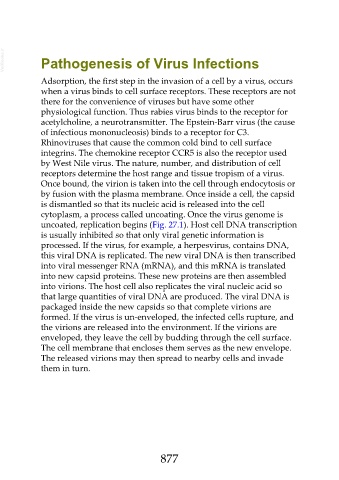Page 877 - Veterinary Immunology, 10th Edition
P. 877
VetBooks.ir Pathogenesis of Virus Infections
Adsorption, the first step in the invasion of a cell by a virus, occurs
when a virus binds to cell surface receptors. These receptors are not
there for the convenience of viruses but have some other
physiological function. Thus rabies virus binds to the receptor for
acetylcholine, a neurotransmitter. The Epstein-Barr virus (the cause
of infectious mononucleosis) binds to a receptor for C3.
Rhinoviruses that cause the common cold bind to cell surface
integrins. The chemokine receptor CCR5 is also the receptor used
by West Nile virus. The nature, number, and distribution of cell
receptors determine the host range and tissue tropism of a virus.
Once bound, the virion is taken into the cell through endocytosis or
by fusion with the plasma membrane. Once inside a cell, the capsid
is dismantled so that its nucleic acid is released into the cell
cytoplasm, a process called uncoating. Once the virus genome is
uncoated, replication begins (Fig. 27.1). Host cell DNA transcription
is usually inhibited so that only viral genetic information is
processed. If the virus, for example, a herpesvirus, contains DNA,
this viral DNA is replicated. The new viral DNA is then transcribed
into viral messenger RNA (mRNA), and this mRNA is translated
into new capsid proteins. These new proteins are then assembled
into virions. The host cell also replicates the viral nucleic acid so
that large quantities of viral DNA are produced. The viral DNA is
packaged inside the new capsids so that complete virions are
formed. If the virus is un-enveloped, the infected cells rupture, and
the virions are released into the environment. If the virions are
enveloped, they leave the cell by budding through the cell surface.
The cell membrane that encloses them serves as the new envelope.
The released virions may then spread to nearby cells and invade
them in turn.
877

